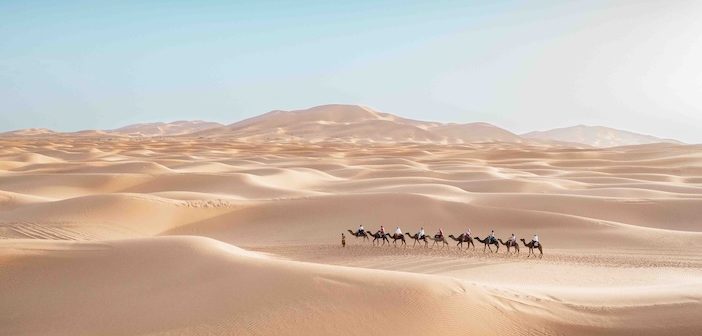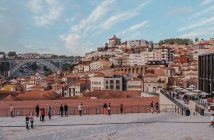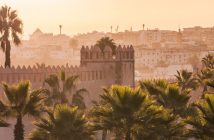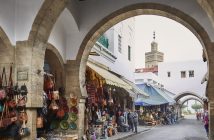Swapping souks for sand dunes, Jane Wilson takes the road less travelled through Morocco’s desert heart, atop camels and under stars, where the only soundtrack is the whisper of the Sahara…
Morocco conjures up images of busy souks, rusty-coloured kasbahs and date palms under amber sunsets. But to really immerse oneself in this land of mystery, it’s advisable to bypass the cities of Casablanca, Marrakesh and Fez and instead take the tracks less travelled, enveloped in sand to be rewarded with spades of culture and buckets of tradition, from a peep into the simplistic Nomadic lifestyle, the wondrous sight of sunrise on camel back and overnighting in a bivouac, in the middle of nowhere.
The adventure started in the oasis town of Erfoud, which was once the seabed of the ancient Tethys Ocean. This region is rich in fossils – trilobites, ammonites, and ancient sea creatures and now mined, polished, and sold around the world bringing work for families using skills passed down over generations. Erfoud is also known for its date festival, a sweet celebration in the middle of the desert. We stayed at the recommended Kasbah Hotel Xaluca which has preserved the traditions of Moroccan style and hospitality. Huge beds, heavy draped fabrics and rug coverings in rich red tapestry designs signified a rich heritage with lanterns accessorised in every corner radiating a mystical ambiance.
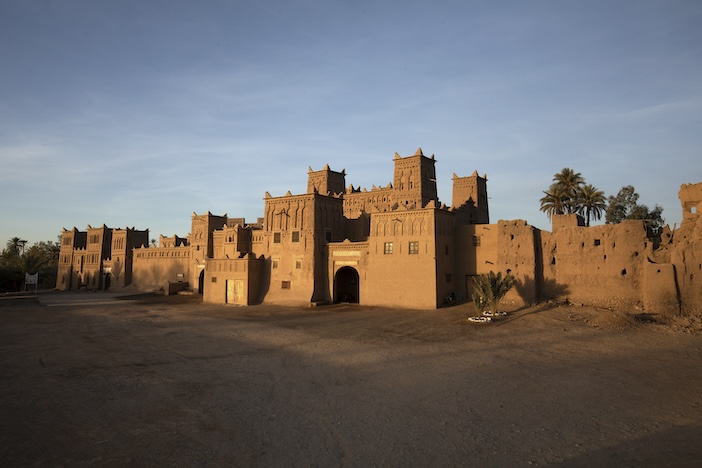
The sheer expanse of the land of the Merzouga Desert, dry and sparse, saw us chase marked tracks and traverse the route used by the Dakar Rally. At times, we ventured off-piste for some sand bashing in 4x4s with shrieks of delight, holding on tight with both hands, as we passed goats and caravans of camels led by farmers. At night desert foxes roam this land. This adventurous off the beaten path steered us to places such as Errachidia, “The Forgotten Frontier”, once known as Ksar Souk. A frontier town, it was rebuilt by the French Foreign Legion in the early twentieth century as a military post. Its stoic order of wide streets and austere façades are still in place. This is where the Saharan belt commences, Amazigh traditions deepen and modern Moroccan life fades.
Shaped by centuries of wind and myth, I sat alone within the undulating dunes of Erg Chebbi, with no human, camel or building in sight to witness the sunrise. The silence was deafening. You can feel the pulse of the desert and the smoothness of the tightly packed grains holding the earth in place. It was a time to allow the brain to rest and use all the senses to blend into the surroundings.
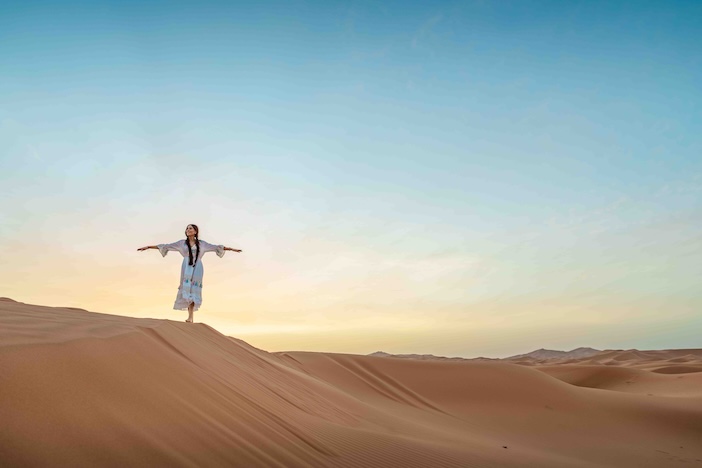
I heard the rustle of the sand change position, saw the shades of rust run through its warm palette as the sun rose, inhaled the aroma of pure air and felt the isolation and comfort of this barren space. And after a while, mindfulness led to reflection to one’s place and purpose on this planet. But then, breaking the magic, Mohammed appeared, like an apparition, to lead me back to my camel for the journey to the camp.
My accommodation was under canvas, flapping in the wind, with a divided section to a modern shower and western WC, layered underfoot with woven rugs carpeting the floors, all cosy and traditional. The overnight stay in a bivouac reminded me of bygone days when travelling was on the hump of a camel, a scarf (or rezza) consisted of metres of cloth worn around the head and mouth to protect against sand storms. Forward to modern day, my rezza appeared more like the look of a dishevelled Lawrence of Arabia rather than the elegance of Nicole Kidman in Queen of the Desert in my head, and dismounting from the camel’s hump less a display of grace and more like a comedy side show.
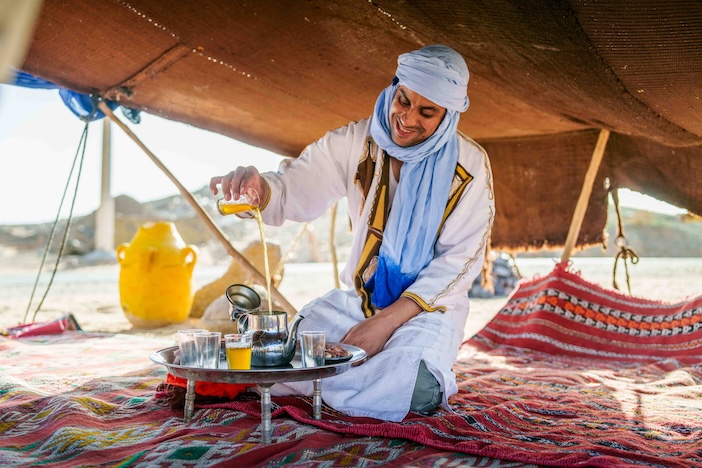
With glinting lamps lighting the land outside, dinner served traditional dishes of succulent pieces of chicken and beef on skewers, mounds of couscous, plates topped with fruit as well as bottles of wines and beers. Entertainment was provided by Berbers dancing and drumming around the campfire, a rather hypnotic and spiritual experience. The dance, known as Ganaoua, together with the use of iron instruments, is a homage to their ancestors. As silence descended out of the glare of the camp light, the darkness highlighted the stars with an appearance of Saturn and Venus as well as the clearest view of the Milky Way. With zero light pollution, this destination is ideal for stargazing.
Within this Ouarzazate region are the Toudgha Gorges, known as Morocco’s Natural Cathedral, an amphitheatre of light and stone with soaring towers cut thousands of years by the force of water carving through solid stone. The walls reach 300m, sheer and majestic. From here rock turns to roses where Rose Valley, within the Dades, brings the bouquet of rose oil, petals and colour. This picturesque and fertile area is renowned for cultivating Damask rose.

The region’s dry mountain air and irrigated land provide the ideal conditions for them to thrive. The Damask rose is cherished here, not only for its beauty but also for its aromatic and medicinal properties, deeply embedded in Moroccan culture. Rosewater and rose oil are highly sought after for their use in cosmetics, perfumes, and culinary products. Small cooperatives in Kelaat M’Gouna and the surrounding areas produce and export them across Morocco and internationally.
Other places to visit include the imposing Taourirt Kasbah, considered one of the most impressive monuments in Morocco, especially with a backdrop of the desert and Atlas Mountains. Built in the 19th century the strategically placed Kasbah controlled the southern caravan route to West Africa, which created wealth and influence for the Glaoui clan back in its day. In addition is the famous Kasbah Ait Ben Haddou, a UNESCO World Heritage Site and an ancient fortress that has been used as a filming location for blockbuster movies such as Gladiator and Game of Thrones.
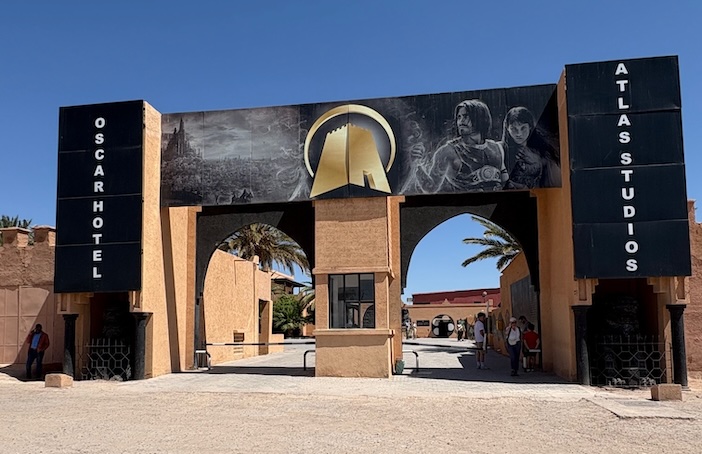
Talking of movies, Quarzazate is known as the ‘Hollywood of Africa’, being the home of Atlas Studios, the largest film studio in the world by land area. Behind the heavy gates, history is projected from multiple studios creating historic blockbusters such as The Jewel of the Nile, Indiana Jones and The Living Daylights. There’s a whole generation of locals who have grown up with cinema and work as extras and camel handlers for crews. But beyond the cameras is a real place, with real narratives and real characters.
Tracing the ancient culture and traditions in the heart of desert uncovers the imbedded soul of the sand. By succumbing to its solitude, we were able to tune in with the rhythm of the ancient land and ultimately to get lost in the Sahara’s golden land without venturing to the bright lights and chaos of big city life.
For more information on Morocco, and to start planning your trip, please visit www.visitmorocco.com.

